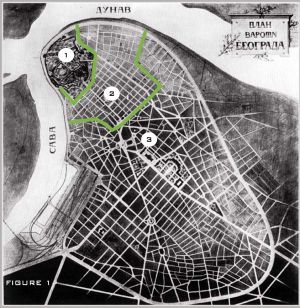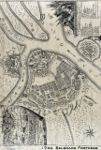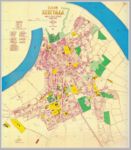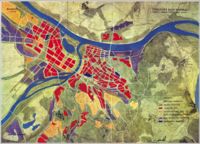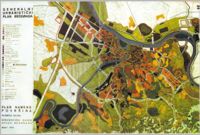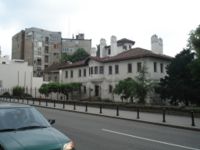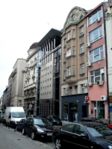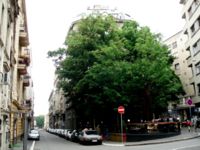(re)Quest for the cultural landscape of Belgrade, Serbia
| Name | (re)Quest for the cultural landscape | |
| Place | Belgrade | |
| Country | Serbia | |
| Author(s) | Jovana Kovacevic, Mirjana Jovanovic, Nada Jadzic | |
| Project start | April 2010. | |
| Completion | July 2010. | |
| World Heritage | not listed | |
| Client | / | |
| Project costs | enter the costs (if known) | |
|
<googlemap version="0.9" lat="44.797400" lon="20.506668" zoom="11" width="400" height="300" controls="small"> </googlemap> | ||
Rationale: Why is the case study interesting?
- Please summarise:- e.g. Design Innovation? Planning Exemplar? Theoretical Insights? Lessons from its failure?
Belgrade, capital city of Serbia, is one of the oldest cities in Europe, was founded by Celts in the 3rd century BC and named Singidunum. Since then begins its long and turbulent history. Archaeological remainings of the first settlements are dating from prehistoric Vincha in the 4800th BC. In the 9th century AD it gets Slavic name Belgrade that was held until today. Throughout its history, Belgrade has been in the government of the various nations, in different countries and had different functions during that period (fortress, Roman limes, capital city). Belgrade conserved prints of all nations and cultures who have lived in it and therefore it deserves this [re]quest for its cultural landscape.
Author's perspective
- What theoretical or professional perspective do you bring to the case study? Please make a short note on your personal background
Under the influence of globalization the city changes its distinctive cityscape, a characteristic human prints are disappearing. We believe it is a critical time to identify and preserve them before they are irretrievably gone. Since in Serbia, the term cultural landscape is not legally defined, this case study opens the possibility to determine whether the cultural landscape of Belgrade exist. If it is recognized as such it could be identified and preserved. That would open perspective for legal regulation of term cultural landscape in Serbia.
Cultural landscape context
- Biogeography, cultural features, overall landscape character, history and dynamics
The specific position of Belgrade, at the confluence of two rivers, at the meeting of the plains and hillside conditioned that it was inhabited from the earliest period (since the Paleolithic). Proximity to water and facilities for fishing, hunting and protected positions on the river banks attracted the first inhabitants of this area. Belgrade’s position may partly explain why the Slavs just settled in that place, as the title Slavs itself means people who live next to the river’’.
Later in history, the position of Belgrade was important in another sense, it meant strategic defense of the borders or the difficult conquest. Dominant position at the confluence of two rivers meant that one that governs the city is the one who controls waterway transport, trade, defense of the city etc. Thus, an important strategic position is the reason that, during its long history, Belgrade was many times conquered by different nations and thereby often destroyed and rebuilt, so that many historical traces disappeared irretrievably. Strategically most important point was the Kalemegdan fortress, located on the hill above the confluence of the Sava and Danube. It is believed that the first fortification on this spot was built by the Celts. Later, Romans built a military fortification there in the first century AD, after which the fort became part of the Roman defensive border (limes). At the same time, it is the oldest part of the city, the core around which the city has later grown.
Most turbulent period of the city and period of its most intense and most frequent destruction and re-building is certainly a period of early 15th century to the mid-19th century. During these 4 centuries, from the moment when Belgrade first became capital of the Serbian state (1403.) to the moment when it became that again, it was conquered several times by the Turks, Serbs and Austria - Hungarians. During this period the city was in constant wavering between Christianity and Islam, on the border between East and West, on the border between the Ottoman and Austria - Hungarian Empire influenced by both of the worlds. This duality is still reflected in its architecture and cultural monuments, and in themselves. However, the modern way of living and the processes of globalization are slowly but surely erasing the prints of cities unique history and character, so that many of them are already gone.
Throughout history, Belgrade has been a major crossroads between the West and the Orient. Belgrade is the capital and largest city of Serbia, the city has an urban area of 360 square kilometers, while together with its metropolitan area it covers 3,223 km2. Belgrade lies 116.75 meters above sea level and is located at confluence of the Danube and Sava rivers. The historical core of Belgrade, today's Kalemegdan, is on the right bank of the rivers. Since the 19th century, the city has been expanding to the south and east, after World War II, New Belgrade was built on the Sava's left bank, merging Belgrade with Zemun.On the right bank of the Sava, central Belgrade has a hilly terrain, while the highest point of Belgrade proper is Torlak hill at 303 m. The mountains of Avala 511 m and Kosmaj 628 m lie south of the city. Across the Sava and Danube, the land is mostly flat, consisting of alluvial plains and loessial plateaus.
In the very center of Belgrade, were found, Neanderthal skeletons who was killed in battle with the mammoth, which is evidence of the prehistoric times on today’s territory of Belgrade. The Neolithic Starčevo and Vinča cultures existed in Belgrade and dominated the Balkans (as well as parts of Central Europe and Asia Minor) about 7,000 years ago(4800 BC). The Paleo-Balkan tribes of Dacians and Thracians dwelled in the area before being settled in the 4th century BC by a Celtic tribe, the Scordisci, the city's recorded name was Singidūn, before becoming the romanized Singidunum in the first century AD. In 34-33BC the Roman army under Silanus reached Belgrade. In the mid 2nd century, the city was proclaimed a municipium by the Roman authorities, evolving into a full fledged colonia (highest class Roman city) by the end of the century. In 395 AD, the site passed to the Eastern Roman or Byzantine Empire. Across the Sava from Singidunum was the Celtic city ofTaurunum (Zemun), Singidunum was occupied and often ravaged by successive invasions of Huns, Sarmatians, Gepids,Ostrogoths and Avars before the arrival of the Slavs (which means people who live near water) around 630 AD. The first records of the Slavic name Belgrade dates back to 878th year, during the reign of the First Bulgarian Empire. The city is still continue to be the subject of disputes between Byzantium, Hungary and Bulgaria next four centuries.The city eventually exceeds the power of the Serbs as part of Srem 1284th year.The first Serbian king who ruled Belgrade was Dragutin Stefan (1276-1282), ruler of the Kingdom of Srem. After heavy losses in the Battle of Kosovo 1389th The Serbian Empire began to disintegrate and its southern parts of the high-speed cross into the hands of Ottoman Turks. Serbian despot Stefan Lazarevic Belgrade received from Hungary and Roman King Sigismund of Luxembourg, after which he became his vassal. In 1405thStefan Lazarevic Belgrade declared its capital city. Since that Belgrade has had a great climb. Belgrade has become a refuge to many Balkan peoples fleeing from Ottoman authorities. It is believed that the population at this time high as 40000-50000. During the reign of Đurađa Brankovic, great part of Serbia falls under the Turkish Empire, however, Belgrade came under the protection of Hungarian kings. The Turks wanted to conquer Belgrade because it was an obstacle to further progress towards Central Europe. The army under the leadership of Suleiman the Magnificent, 28 August 1521st won the Belgrade from the Hungarians, which marked the fall of the city under the Ottoman Empire. About 1571stin Belgrade was 27 settlements. The city's 1594th affected a large Serbian rebellion that the Turks were able to repress, burned many churches. In the 16th century the city was quiet and it was an important seat of the county connected by road to Istanbul Constantinople. Attracted many traders and residents - Turks, Armenians, Greeks, Roma and others. He became more than just a city, with Islamic architecture, public bathrooms, and many new mosques. Belgrade is three times from the Turks conquered by Austria (1688-1690, 1717-1739, 1789-1791), and the Ottoman Turks occupied it again, with great destruction. Belgrade becomes “Town of war”. During this period, the city was engulfed by two large migrations of Serbs, in which hundreds of thousands of Serbs, led by the patriarchs, retreated together with the Austrian Habsburg Empire in the 1690th and 1737-39, where they settled in what is now Vojvodina and Slavonia. After the Turkish defeat at Vienna in September 1688th The Austrians captured Belgrade. During the first Austrian conquest (1688-1690) many mosques were destroyed, and those that are left, turned into a Christian church. When the army under the command of the Austrian Empire Archduke Eugene of Savoy for the second time won the Belgrade (1717-1739) destroyed the mosque minarets of the Belgrade fortress, so the panorama of the city can look more European. Then in Belgrade has left the Muslim population because they withdrew in the midst of the invasion. After the victory over the Austrian army 1739th years of Grocka, the Ottoman Turks ruled Belgrade again, and it ruled the next 50 years (1739 to 1789. years). During that time they fix many of the damaged mosques and restored to its original state many turned to the church. During the great battle for Belgrade 1739th years, ruined about 30 mosques. The number of mosques are mostly held by the First Serbian Uprising. The First Serbian Uprising, during the struggle for the liberation of Belgrade 1806th years, many mosques were damaged, the rebels held the city of 8 January 1806th until 1813, when the Ottomans retook it. The Serbian authorities, 1836th The registration of mosques in Belgrade, and that list was found 16 mosques. Eviction "Turkish" population from Beograda1867. Today the only remaining mosque in Dorcol Bajrakli. Since 1817th was the capital of the Principality of Serbia When the Serbian gained full independence 1878th and became the Kingdom of Serbia, Belgrade has again become a key city in the Balkans that is rapidly developing. Belgrade in 1900. had only 69,100 inhabitants. Soon, 1905th population is growing at more than 80,000, and at the beginning of World War 1914th and up to 100,000, not counting Zemun which then belonged to Austria Hungary.. After the First World War and the occupation by the Austro-Hungary and German troops, Belgrade has experienced rapid growth and a significant modernization of the capital of the new Kingdom of Yugoslavia. A little known fact that Belgrade was then one of the first Buddhist temple in Europe. During the twenties and thirties of the 20th century, the population would grow to 239 000 to 1931st together with the western suburb of Zemun, who was formerly in Austria-Hungary. By 1940, the population was about 320,000. Yugoslavia on 25 mart 1941. signed the Tripartite Pact and joined the Axis powers. Because of this, on 27 March followed by mass protest in Belgrade and the coup. The city is 6 and 7 April heavily bombed by the Luftwaffe, killing 2274 people. The bombing was set on fire and burned the National Library of Serbia, where they killed thousands of books and medieval manuscripts. Yugoslavia was attacked by German, Italian, Hungarian and Bulgarian forces, with the help of the Albanians and Croats. After the capitulation of the Kingdom of Yugoslavia, in Belgrade and central Serbia have supported the establishment of the Nazi government of Milan Nedic Jews, Gypsies, communists, and other antifascists were taken to concentration camps and fairground Banjica, through which he passed during the war, about 125,000 inmates. Semlin killed about 40,000 Jews, Serbs and 7-8000 [32] [33]. In Banjica killed about 4200 people. Executions carried out by the German occupiers, while the prisoners were arrested mainly Serbian quislings, who had done the administration of Banjica camp. The city was bombed and Allies 16th and 17 April 1944. Struggle for the liberation of the town started 13th and 14 October, the city was finally liberated 20th October 1944. Liberated by the joint forces of the partisans and the Red Army. During the war, Belgrade lost about 50,000 people and suffered heavy destruction [30]. In the postwar period, Belgrade has developed as the capital of the new Yugoslavia, and soon grew into a major industrial center. In 1951 began the construction of New Belgrade on the other side of the river Sava, where they were previously located just marsh and reeds. The city was, at least in the beginning, build voluntary youth work brigade. The first Conference of NAM held in Belgrade 1961st year. Belgrade was the scene of large student demonstrations 1968th March 1972nd Belgrade is the center of the last outbreak of smallpox in Europe. Epidemic, which included a forced quarantine and mass vaccination ended in late May. In May 1980th death is life president of Yugoslavia, Josip Broz Tito. In addition to nearly all the world's leading statesmen, and the funeral was attended by about 700,000 people. '
Illustration: Map; sketches; short descriptive analyses
Socio-political context
- Brief explanation of political economy, legal framework
Sociological, economic and political relations have greatly influenced the image of the city. Often happened in the history that the new government and a new ruler destroyed what remained from the previous government by building a new insignia, regardless whether the cultural values was destroyed. For example, in the early 20th century, after Serbia achieved independence from Ottoman Empire, the Serbian rulers destroyed everything associated with the period of Turkish government, so today there are very few remaining of Ottoman period of Belgrade, unfortunately.
This was particularly expressed after the World War II, when communists came to govern the country; they wanted to erase all traces of previous kingdom governance, so they tear down many important historic and cultural landmarks (such as the very first tram line in Belgrade that was connecting city centre and the former king’s residence, to name only one of many examples). That was period of intensive after-war reconstruction and construction throughout entire country of former Yugoslavia, and Belgrade, as the capitol city, endured profound changes.
Next important changes of Belgrade’s cityscape came during the civil war in former Yugoslavia from 91-95, when the Belgrade was governed by the power of money (corruption among city officials was common thing), which was enhanced by huge economic crises of entire country, accompanied by cultural and social crisis of the whole society. That was the time when the power and political influence were in the hands of rich businessmen with suspicious origin of their money. On the outskirts of the city was developed a large suburbs with no adequate infrastructure. At the same time in the area of historic centre there was uncontrolled illegal construction, old valuable buildings (even entire quarts) were demolished and new ones erected, without any plan; some old buildings have been upgraded with new materials, and so, even today, one can see in the city ugly and “unnatural” hybrids of beautiful old buildings which were added elements of glass and steel. At that time irretrievably disappeared some city attributes that kept Belgrade’s genius loci. ( such as traditional restaurants, art galleries, etc...), But some of them, fortunately, managed to resist the pressure and they still exist and give us hope that one day Belgrade’s cultural landscape could be found.
Lack of specific, adequate and applicable laws and disrespect of existing ones contributed in a large scale to this situation. Unresolved property relations have also had a negative impact. Owners of objects that could have cultural values have not been required to wager in the restoration and preservation, when the state was not able. The result is what we have today - remains of the historic center is scattered among modern and stylish inconsistent buildings, ambient parts of the old town only reminiscent of what they once were, and cultural and historical heritage are slowly disappearing.
Spatial analysis of area/project
- What are the main structural features?
Belgrade is a city that has often changed its face during its turbulent history has. Frequent changes have caused following: areas in the inner city center have been planned developed while part of the periphery developed uncontrolled; later, as the city spread to the peripheral areas, they have been incorporated in the city, either through restructuring or, if it was not possible in their original form, which has created a problems in the further expansion of the city regarding organization and urbanization. This caused the appearance of a different urban zones - zones that are arranged and organized (properly developed city fabric matrix) and areas with no visible organization (twisting streets, blocks of different sizes ...) The phases of this historical development of Belgrade can be observed at overall urban city structure
Figure 1:
Urban plan of Belgrade from the 1912. It can be observe regular and unregular built urban tissue.
Zone 1: Fortress is the oldest part of the city; it have been inhabited from the foundation of the city. Main function was military fortification. Inside the walls there was militery and rich Turkish people, out side the poor one. Organization of space inside the fort is more or less correct, according to the functions that the city had.
Zone 2: As the city was developing , it expanded outside the fortress, surrounded by a moat along which there were four gates, which represented a new outer fortification. The area between the fortress and moat is characterized by regular street network that was developed according to plans when the city expanded to the area. This area have changed a lot after the liberation from the Ottoman Empire; after achieving independence the Serbian government did not want to keep anything that defined Turkish government, and so now, for example, from twenty of the former mosque in Belgrade, unfortunately, only one remained. This part of Belgrade has always been a center of culture and commerce. This part of town has the most potential to develop a unique cultural landscape, as it is the old city core which includes some of the oldest and most valuable buildings and environmental entities in Belgrade.
Zone 3: The area outside the moats and fortifications is area outside where have had lived the Serbian people. During the 19th century, this area developed as the city periphery, with no plan, so it is apparent irregular street network, due to unplanned development and the topography of the terrain.
- How has it been shaped? Were there any critical decisions?
The development of Belgrade
1867th year Urban plan Emilijan Josimović, during the Turks, the development of the city within the walls and outside the moat. Towns plan in trench E. Josimovića treats historical center of Belgrade, including the famous Old quarter of the Danube to the Savi: Dorćol quarter, Varos quarter and part of the Baroque and the Belgrade Fortress with its Esplanade, which has now been turned into a park area: little Kalemegdan, the Great Kalemegdan, Lower Kalemegdan and Zoo.
1912th Master Plan Alban Shambon, made on the basis of surveying plan from 1909th year. As a supporter of Alban Shambon tendency historicism or eclecticism, on the basic idea for the reconstruction of Towns implemented, reinterpretation of history and world architectural heritage. Sambons plan provides a very valuable suggestion circular boulevards, gorgeous Turkish scale, clearly separating the construction area from the rest of the city territory.
1923th Urban plan, Djordje Kovaljevski, Master plan has been developed and adopted 1923th, but without adding that relates to New Belgrade. The plan is authorized Minister of Construction 19th July 1924th year. Supplement relating to the New Belgrade is a typical example radial - composite solutions. After a number of competition decisions, after the Second World War, today's decision is a typical example of functionalist-composite doctrine.
Critical decisions, were certainly made, Belgrade in its history has been changing every time with changing of the government. In the past and now, in the present, each regency, is trying to leave their mark. A number of years of war that struck Belgrade, have influenced the decline society and their social status, what can today be seen as a cultural landscape of Belgrade released a decline, due to penury and property issues, the State recognizes the case as private property and do not want to invest in their survival or if they invest with little involvement. Important is also, the fact that there isn’t a law that defines the cultural landscape.
Illustration: Map/diagram/sketches photos and background notes
Analysis of idea/program/function ("Planning Objective")
- What are the main functional characteristics?
- How have they been expressed or incorporated?
Illustration: Map/diagram/sketches photos and background notes
It is notable the policy of demolition of the old structures and new construction (buildings, commercial complexes, open space) regardless of whether it is really necessary or not. We are not paying much attention to whether the newly built fit into the existing picture of the city and the landscape. Functional features are specific townscape that is a combination of different styles of construction and the various elements. Some parts of the townscape are preserved and have kept their original urban functions (residential areas, business, culture, etc.), while others, unfortunately, irretrievably changed their appearance and lost some very characteristic and valuable cultural attributes. By protection of certain structures and even entire streets, it is possible to prevent the disappearance of the cultural identity of the city which once existed in this region.
At the same time during last years there is a shift in the understanding of the importance of cultural heritage, history and tradition, and therefore arise and the various initiatives that are related to this topic. However, this comes down to the individual and unrelated cases that, by themselves, cannot significantly change the state of affairs. On the other hand, the main decision-makers - the city and state officials responsible for culture are expressing interest in this issue, but for now it remains in area of plans, without concrete realization. The interest of experts and interest (though for the time being insufficient) of politicians on this subject implies that the described problems in will be seriously addressed the (hopefully near) future.
Analysis of design/planning process ("Process Biography")
- How was the area/project formulated and implemented?
- Who initiated the project and why?
- Which stakeholders have been involved?
- Who made the major decisions and when?
- Were there any important consultations/collaborations?
Illustration: Map/diagram/sketches photos and background notes
In case of Belgrade, there is no concrete plan or project related to the cultural landscape that is being implemented, so that this case study is formulated as our own research and quest for the historical elements of cultural landscape and opportunities for its implementation.
Disappearance of specific character of the city, some historical elements and irreversibly lost genius loci in some parts of the city is obvious, and any initiative for plans, strategies and projects in this area would be of great importance. The professional community is interested to preserve and restore part of the city that can be considered a historical core of Belgrade, but there is no adequate legal framework or institutions through which it could be realized. Potential drivers of regeneration project of the historical city center could be experts in various relevant areas, municipal authorities, NGOs, and city authorities or individuals - city officials.
Main stakeholders in the implementation of future plans would be
- State institutions
- private sector / investors
- public (public participation)
- NGOs
- citizens and so on.
For realization of future plans and strategies certainly is necessary professional basis. This requires training of professionals from different fields (art history, architecture, landscape architecture, construction, politics ...) and the formation of multidisciplinary teams. It is also advisable to consult experts from European cities that have in the past faced similar problems.
Initiation and implementation of plans in this area would contribute to a tourist offer of the city, but would have significant educational aspects also. Potential users would be tourists, citizens of Belgrade and all the others.
Analysis of use/users
- How is the area/project used and by whom?
- Is the use changing? Are there any issues?
Illustration: Map/diagram/sketches photos and background notes
No data available
Future development directions
- How is the area/project evolving?
- Are there any future goals?
Illustration: Map/diagram/sketches photos and background notes
Future development directions would be:
- adoption of goal oriented strategies for city development and their implementation
- adoption of plans for the regeneration / reconstruction of the historical city center
- adoption of adequate legal framework
- development of partnership between the private and public sector
- restructuring of institutions dealing with the protection of monuments of culture
- training of professionals and development of interdisciplinary research
- monitoring and implementation experience of European countries
Peer reviews or critique
- Has the area/project been reviewed by academic or professional reviewers?
- What were their main evaluations?
No data available
Successes and limitations
- What do you see as the main successes and limitations of the area/project?
Illustration: Summary table
No data available
What can be generalized from this case study?
- Are there any important theoretical insights?
Elements of cultural landscapes do exist in the form of residues in the central zones of the city (individual buildings, streets and parts of the environmental entities).This is the result of the neglect of cultural values in the past, during various periods in the development of the city.
The usual manner that led to the degradation of the cultural heritage of the city: the old building is a very famous old café in Belgrade, one of the oldest built in 1829th. Now it has the status of protected cultural monument. Next to this building once were the first Serbian post office (built 1840.) and the first Serbian pharmacy (built 1830.); these were torn down during period of communist governance and constructed a new, currently existing, which led to irretrievable lost a unique cultural and historical streetscape.
There is a real possibility of regeneration of the historic core of the city and the establishment of cultural landscape. Problems in achieving objectives:
- absence of a clear strategic policy for development of cultural landscape,
- lack of adequate institutions to deal with this topic,
- unresolved ownership relations,
- lack of legal framework (currently law in force does not recognize the term "cultural landscape")
- disinterest of the private sector for investment (investors do not see the economic viability of investments)
- lack of financial resources
The problem that Belgrade faces is not new, many European cities were in similar situation in the past, and we should use their experience and adopt an appropriate model of urban regeneration.
What research questions does it generate?
During research work for this case study we came to conclusion that it is possible to stop this kind of degradation and, by applying specific models ( known from the experiences of other European cities) restore the historic city core, its genius loci and to establish a cultural landscape of Belgrade.
Image Gallery
- Yourimage.jpg
your image text and source
- Yourimage.jpg
your image text and source
References
- Author Year: Title, publisher, edition, page, ...
- etc.
- Website Year: Link, keyword, ...
- etc.






